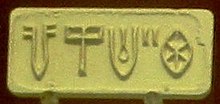
Back Indusskrif Afrikaans الكتابة السندية Arabic Escritura del Indo AST Indus Schrift BAR সিন্ধু লিপি Bengali/Bangla Escriptura de l'Indus Catalan Harappské písmo Czech Indusschrift German Escritura del Indo Spanish خط ایندوس Persian
| Indus script | |
|---|---|
 Seal impression showing a typical inscription of five characters | |
| Script type | Undeciphered;
possibly Bronze Age writing or proto-writing |
Time period | c. 3500–1900 BCE[1][2][a] |
| Direction | Right-to-left script, boustrophedon |
| Languages | Unknown (see Harappan language) |
| ISO 15924 | |
| ISO 15924 | Inds (610), Indus (Harappan) |
The Indus script, also known as the Harappan script and the Indus Valley Script, is a corpus of symbols produced by the Indus Valley Civilisation. Most inscriptions containing these symbols are extremely short, making it difficult to judge whether or not they constituted a writing system used to record a Harappan language, any of which are yet to be identified.[3] Despite many attempts,[4] the "script" has not yet been deciphered, but efforts are ongoing. There is no known bilingual inscription to help decipher the script,[5] which shows no significant changes over time. However, some of the syntax (if that is what it may be termed) varies depending upon location.[3]
- ^ Kenoyer (2006), pp. 10–11.
- ^ Bryant (2001), p. 178.
- ^ a b Locklear, Mallory (25 January 2017). "Science: Machine learning could finally crack the 4,000-year-old Indus script". The Verge. Manhattan, New York, NY: Vox Media. Retrieved 25 January 2017.
After a century of failing to crack an ancient script, linguists turn to machines.
- ^ Possehl (1996).
- ^ Robinson (2015).
Cite error: There are <ref group=lower-alpha> tags or {{efn}} templates on this page, but the references will not show without a {{reflist|group=lower-alpha}} template or {{notelist}} template (see the help page).
© MMXXIII Rich X Search. We shall prevail. All rights reserved. Rich X Search